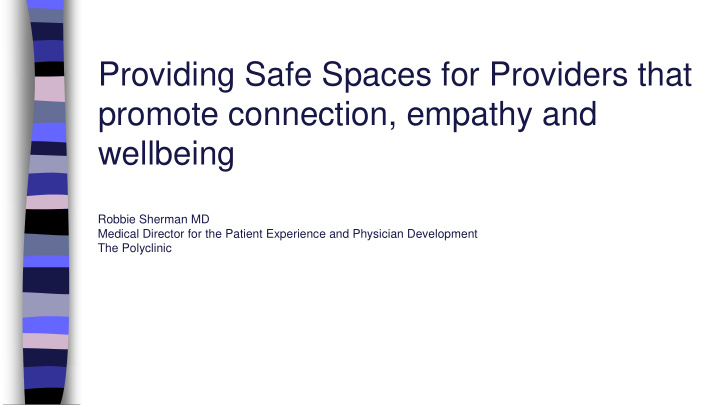



Providing Safe Spaces for Providers that promote connection, empathy and wellbeing Robbie Sherman MD Medical Director for the Patient Experience and Physician Development The Polyclinic
Loss of Meaning
Impoverished Relationships
Increasing Conflict
Demoralization
Emotional Distancing
Exhaustion
Reset
Balint Groups
Balint Groups are case based discussion groups for physicians, mental health providers, nurses, chaplains, social workers and others. The topic of discussion is the relationship. The emotional content of the case is central rather than the serum sodium or clinical facts.
“At the center of medicine there is always a human relationship between a patient and a doctor.” -Michael Balint
Michael Balint Born in 1896 in Budapest, son of a GP Psychoanalytic training in Berlin and Budapest, emigrated to London, worked at the Tavistock Clinic He and his wife, Enid, began the training/research seminars for GPs after WW II 1957 “The Doctor, his Patient and the Illness” published
What a Balint Group is Not Psychotherapy Group Encounter Group Traditional Case Consultation Group Topic Discussion Group Personal and Professional Development Group Not prescriptive, didactic, advice giving
Characteristics of a Balint Group Ideally fixed membership Two leaders Focus on doctor-patient relationship Power of the group Preference for an ongoing case Less conscious aspects of relationship
Ground Rules Confidentiality Respect, Turn Taking Avoid Advice Ownership
The Group’s Job: Imagine Alternative Viewpoints Problem- Solving
Cases Presentations are spontaneous Patients we have ongoing relationships with Patients who we feel conflicted or strongly about Patients that leave us feeling unfinished, who we lose sleep over Patients that bubble up in the moment
A Case Arrives Leader Angela is a 79 yr old blind woman…. Leader Presenter
Clarifying Questions Leader Are there any clarifying questions? Leader Presenter
The Presenter “Gets” to Listen Leader Why don’t we let the presenter just listen while we work the case Leader
The Group Starts Working Leader I imagine Angela to be… Leader Presenter
Imagining Patient and Doctor Leader If I were the doctor, I might feel… Leader Presenter
Group Exploration Continues Leader This image just popped into my mind of a… Leader Presenter
Functions of a Balint Group To provide a safe place for emotional reflection on troubling cases To help presenter consider other understandings about the case To look at blind spots, assumptions To help members feel less isolated, less shame, more open to learn To help members grow and develop
Benefits for Physicians Explore difficult or troubling situations Refine crucially important patient-doctor relationship skills Hear and learn from others’ cases Connect with others Experience the power of a group Remember what matters about our work Avoid burnout, increase engagement and resilience
Resilience
Cultural Competence
Remoralization
Find Out More About Balint Groups The American Balint Society offers training and experiences nationally www.americanbalintsociety.org The Northwest Balint Circle is an association of local medical and mental health professionals with Balint training. They offer presentations, demonstrations and ongoing groups. http://northwestbalintcircle.org/
Recommend
More recommend